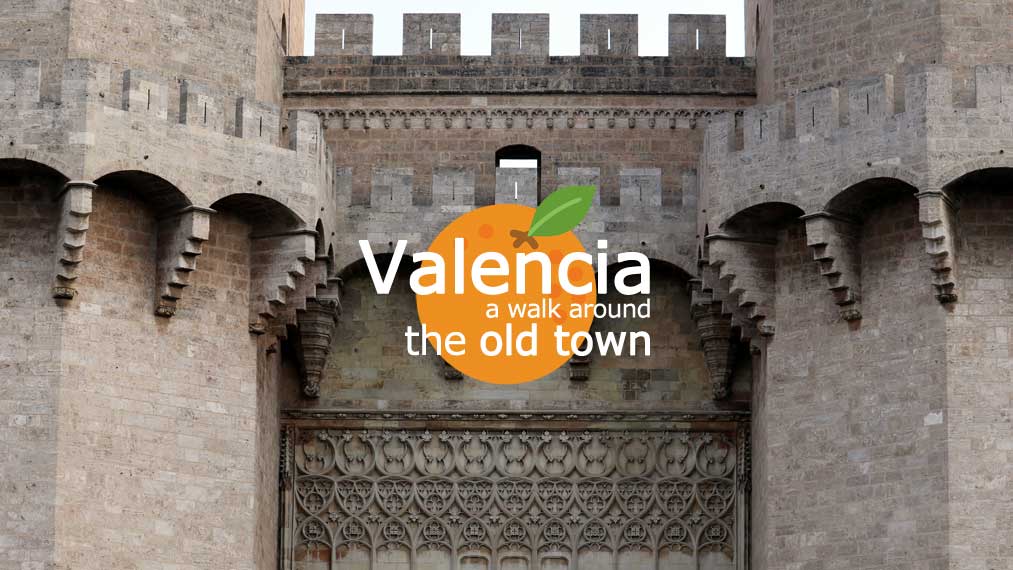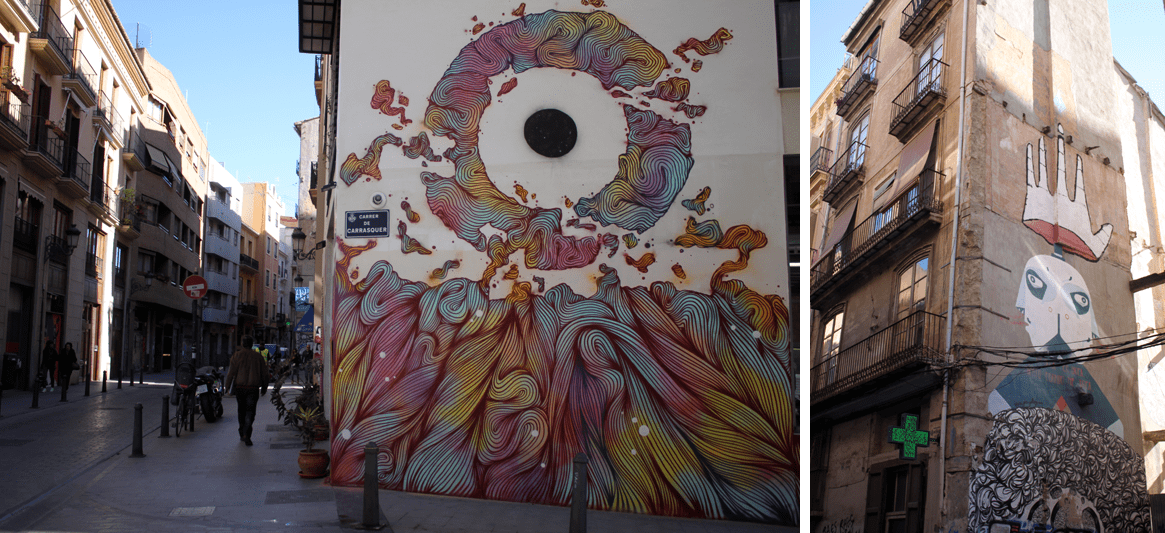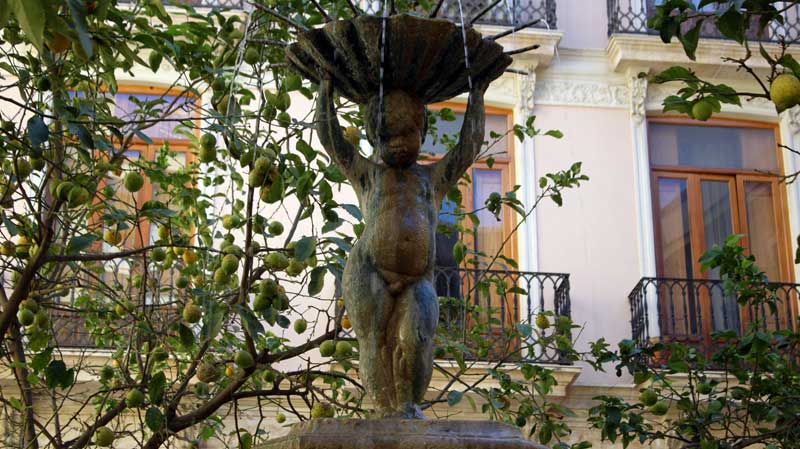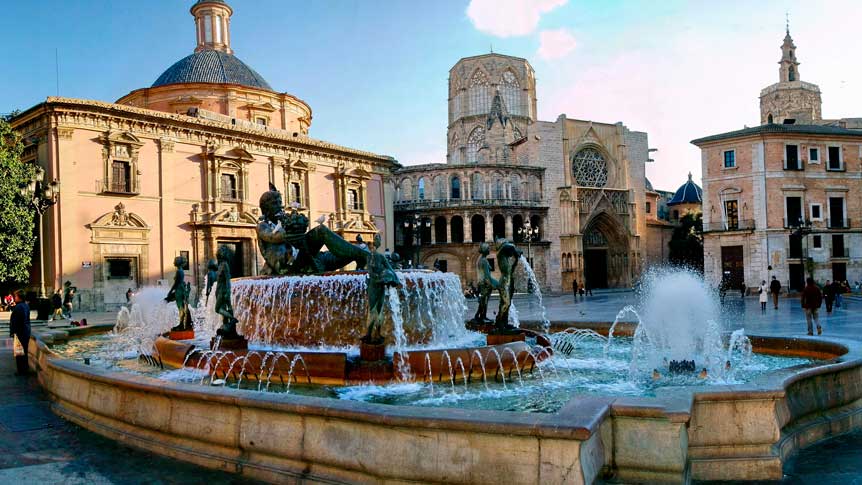Do you want to see more of Valencia, but you are not sure where to start? Join us on a tour of the Old Town, and see what you can discover about the history of Valencia in an hour!

Our walk starts at the Torres de Quart, one of the two remaining medieval gates to the city. Originally a part of the old city wall, these towers were built in the Valencian Gothic style during the 15th century to defend the city against any outside attacks. They have served their purpose during the Peninsular War, the War of the Spanish Succession, and the Spanish Civil War: in fact, you can still see on the outer walls of the towers the damage left by the bombardment during the French siege of the city in 1808.

The medieval city wall was demolished in the 19th century, and only the gates Torres de Quart and Torres de Serranos remain standing. If you want to see the Old Town of Valencia from a different perspective, you can climb to the top for €2 (€1 for students with a youth card). On Sundays and public holidays the entry is free.
From here we continue our walk on Calle Quart towards the heart of the Old Town. On this route you will see a lot of interesting and colourful street art:

Soon you will reach Plaza del Tossal, a city square that during the day is a meeting point for many and during the night really comes alive. At the plaza there are many restaurants, bars, and nightclubs, so if you are looking for a way to spend your Saturday night, return here!
At the plaza there is also an underground surprise waiting for you. If you take the stairs down to Galería del Tossal, you will find a museum dedicated to the remains of the city wall from when Valencia was under a Muslim rule. If you are interested to know more of this period of Valencia’s history, go check it out!
With over 2100 years of history and a vibrant, cosmopolitan life, Valencia is the perfect blend between tradition and avant garde
From Plaza del Tossal we continue straight onwards on Calle Caballeros. In the past the street used to belong to the nobility in Valencia: in fact, the name caballeros, “gentlemen” or “knights”, refers to the social status of its old inhabitants. Some of the buildings on the street are former palaces of the Valencian noble families that have now been converted into restaurants and other businesses.
Blink and you will miss it! On Calle Caballeros you can find one of the hidden treasures of the city, the church of Saint Nicholas.
Founded in the 13th century, the church is built in the Gothic style. The entrance to the church from the street is a long narrow passageway that almost goes unnoticed, as the only visible indication that there is a church is a delicate iron cross at the top of a door. But paying a visit inside is worth more than the few euros you pay for the entrance.

The insides of the church were finished in the late 17th century and are decorated in the rich Baroque fashion of the time. The frescoes depict the lives of Saint Nicholas and Peter of Verona, the saints the church is dedicated to. The church was under renovation until just recently to save these amazing pieces of art from deterioration.
After paying a visit inside the church we continue our tour back on Calle Caballeros, only making a detour to Calle Calatrava to see Plaza del Negrito, another public square that is a popular meeting point — an alternative to Plaza del Tossal if you are looking to get to know the Valencian nightlife.

The plaza got its name from the dark cast iron statue perched at the top of the fountain in the middle of the square depicting a little boy. In 1850 the city installed pipelines for drinking water and public fountains where everybody had access to it: the fountain at the plaza was one of these. The fountain with its little statue soon became a landmark after which the square was renamed. Before that the plaza had been simply known as Plaza de Calatrava.
As we return to our main route, next on Calle Caballeros we see Palau de la Generalitat — it is not easy to miss, really. First constructed in 1421 in the Valencian Gothic style, the building has undergone many modifications during the centuries. Since its initial construction the building has functioned as the headquarters for the rulers of Valencia, and today it houses the government of the autonomous Valencian Community Generalitat Valenciana, hence the name.
The heart of the city
From the government building you can already see our next stop: Plaza de la Virgen, arguably one of the most impressive plazas in the city. On one side of the square you have restaurants, cafes, and terraces where you can stop for a bite or a drink, and on the opposite side are some of the most historically impressive landmarks of Valencia: Basílica de la Virgen de los Desamparados, Catedral de Santa Maria, and Fuente del Turia, a fountain dedicated to the old river Turia.

The plaza has been here since the Roman times, and has therefore always been an important part of the cityscape of Valencia. The oldest landmark around the plaza, the cathedral was for the most part built between the 13th and the 15th century: as the construction took centuries, the result it is a mix of architectural styles from Valencian Gothic to Baroque and more. The cathedral has three main doors only one of which is visible from Plaza de la Virgen. At this door the Water Tribunal of Valencia meets every Thursday at noon in a public proceeding, following the 1000-year-old tradition of settling conflicts rising from the share and use of irrigation water around Valencia.
The basilica was built in the 17th century in the Baroque style. Dedicated to the patron saint of the city, Virgin of the Forsaken, the basilica is a home to a statue of the Virgin and also has frescoes worth seeing.

From the plaza we walk the passageway between the basilica and the cathedral to our final stop: Plaza de Décimo Junio Bruto, slightly less impressive in its appearance, but with massive historical value. You see, while the whole Old Town of Valencia is built on the previous installations of the city from Roman to Visigothic times, at this plaza you will find Museo de la Almoina dedicated to the Roman ruins unearthed at the location in the 1980s.

In the museum you can discover the beginnings of Valencia and see the marks left by Romans, Visigoths, and the Muslim rulers, right at the heart of the historical centre of the city. Entrance to the museum costs €2 (€1 for students with a youth card), but on Sundays and public holidays it is free.
What are you still waiting for? Go explore this wonderful city!











